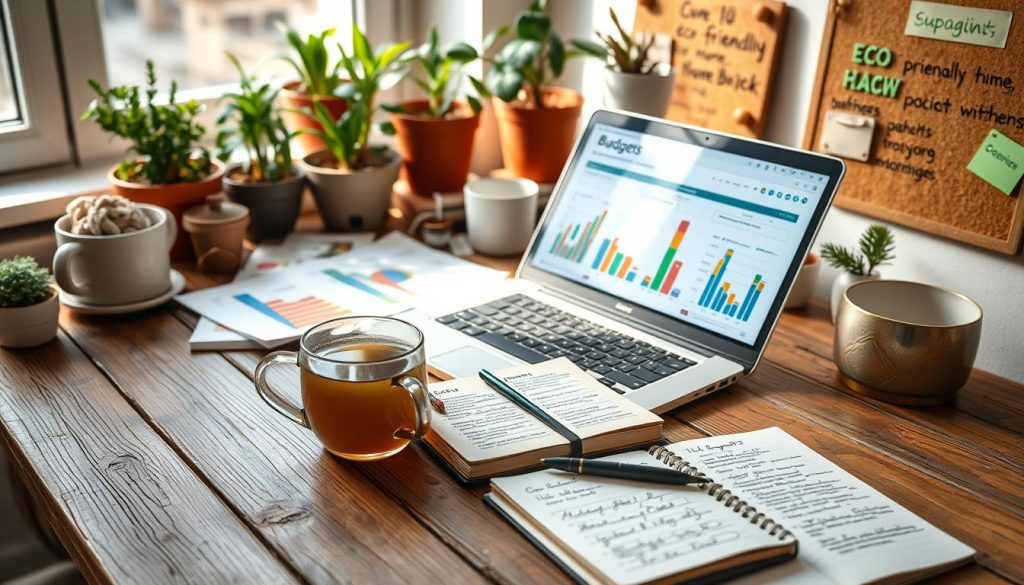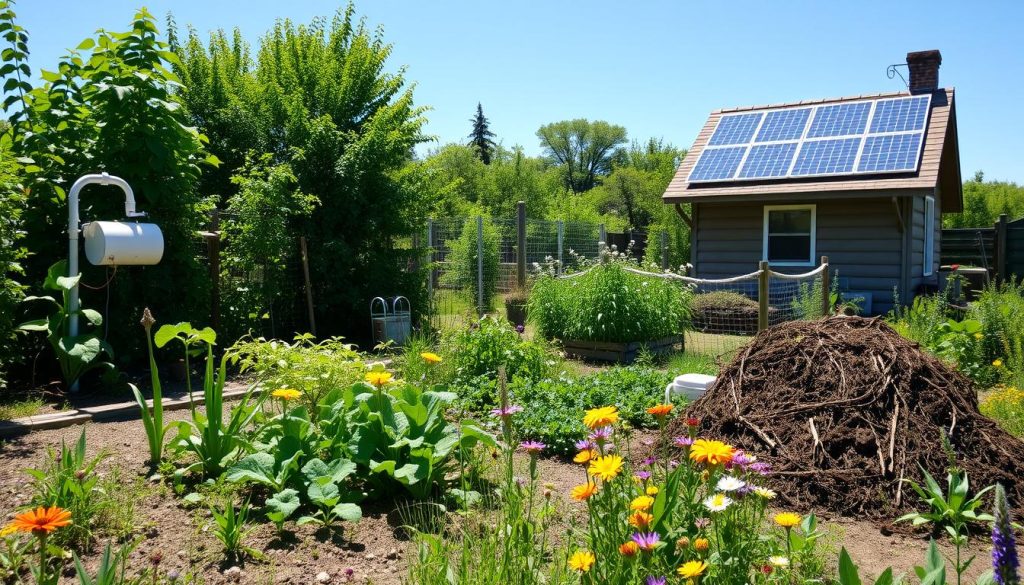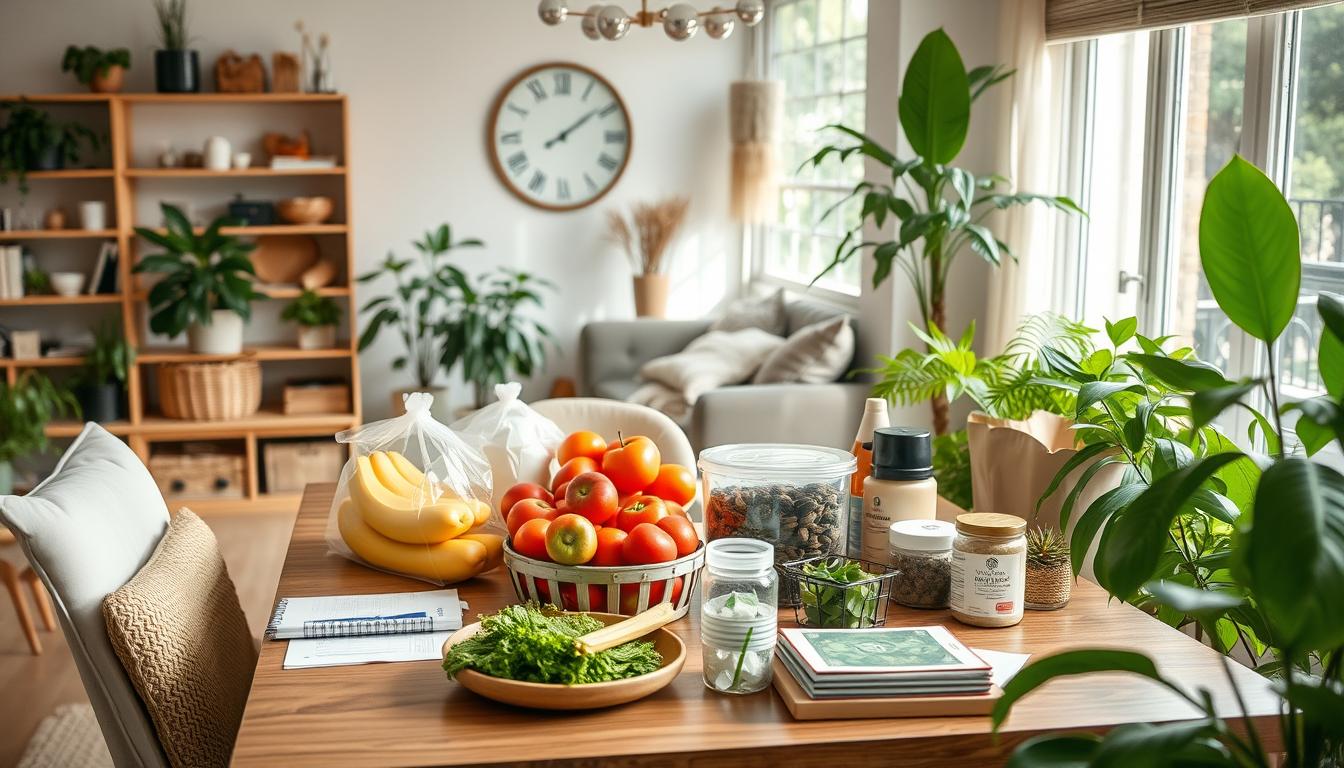Creating a sustainable living budget is key to living eco-consciously. It helps us reduce our environmental impact and saves money. The United States Environmental Protection Agency (EPA) supports sustainable living to lessen our footprint.
There are many benefits to eco-conscious budgeting. It can save money and improve our health. Financial experts say it’s smart to make sustainable choices in our daily spending. In the U.S., many people are managing their money and the planet at the same time. This guide will show you how to make a budget that’s good for both your wallet and the environment.
Understanding My Sustainable Lifestyle Goals
Starting a sustainable journey means knowing my goals and planning my finances. This part will help me define my sustainability goals and fit them into my budget.
Defining What Sustainability Means to Me
Sustainability means different things to different people. For me, it’s about cutting down on carbon, supporting green energy, and picking eco-friendly stuff. Thinking about what sustainability means to me helps me focus on my spending habits.
Identifying My Priorities
Knowing what sustainability is, I need to figure out what’s most important to me. It could be less waste, green energy, or buying local and organic. Setting these priorities helps me stay focused and ensures my spending matches my values.
Setting Realistic Financial Goals
It’s key to set financial goals that are doable. Breaking big goals into smaller steps, like saving for green products or home upgrades, keeps me motivated. This way, I can balance my green dreams with my wallet’s needs.
Here’s a table to help me get started:
| Goals | Actions | Budget Allocation | Timeline |
|---|---|---|---|
| Reduce Waste | Switch to reusable products | $50 monthly | Ongoing |
| Support Renewable Energy | Invest in solar panels | $3,000 upfront | Within 12 months |
| Buy Organic Foods | Prioritize local farmers markets | $100 monthly | Ongoing |
Analyzing My Current Spending Habits

Understanding where my money goes is key to living frugally. By tracking my expenses, I can find where I spend too much. This helps me save money and live more sustainably.
Tracking My Expenses
Tracking my spending shows me my financial habits. I use apps like Mint and YNAB to log every purchase. These apps give me real-time feedback and reports to improve my budget for green living.
Identifying Non-Essential Purchases
Reports show common non-essential buys. By spotting these in my spending, like online impulse buys or eating out too much, I can cut back. This leads to more thoughtful spending for a frugal lifestyle.
Categorizing My Spending
After tracking and identifying non-essentials, I categorize my spending. I break down my budget into areas like transportation, groceries, entertainment, and eco-products. This helps me see where my money goes and plan better for green choices:
| Category | Percentage of Budget |
|---|---|
| Transportation | 15% |
| Groceries | 30% |
| Entertainment | 10% |
| Sustainable Products | 20% |
| Miscellaneous | 25% |
Creating a Budget That Supports Sustainability

Starting a sustainable living budget means changing how I spend money. It’s good for the planet and can save me money in the long run.
Allocating Funds for Eco-Friendly Choices
I need to figure out how much of my budget can go to green purchases. Cutting back on things I don’t need helps. Buying energy-saving appliances or reusable items might cost more upfront but saves money later.
Planning for Sustainable Investments
Planning for green investments is key. Studies show that solar panels can lower utility bills and boost property value. Setting aside money for these investments is smart for both my wallet and the planet.
Budgeting for Local Foods and Products
I also focus on buying local foods and products. Buying from local farmers cuts down on carbon emissions and supports the local economy. It’s cheaper and healthier to eat seasonal, locally-sourced food. Having a special part of my budget for this ensures I’m making eco-friendly choices.
Finding Ways to Save While Living Sustainably

Living frugally and sustainably can save a lot of money. It doesn’t mean giving up on being eco-friendly. With some smart tips, I can keep my green living costs down.
DIY Projects to Cut Costs
Doing DIY projects is a great way to save money. Making my own cleaners and fixing up old furniture are just a few examples. These activities not only save cash but also help the planet.
Trying out homemade products has opened my eyes to new ways to live greener. It’s fun and helps me reduce my environmental impact.
Utilizing Community Resources
Using community resources is another smart move. Places like tool libraries and shared gardens offer what I need for free. It’s a win-win for everyone involved.
By joining these efforts, I help create a more circular economy. It also keeps my green living expenses low.
Taking Advantage of Sales and Discounts
Keeping an eye out for sales on eco-friendly items is wise. With more discounts on green products, I can buy what I need for less. It’s a great way to save money while staying true to my green values.
Monitoring and Adjusting My Budget Over Time
Keeping up with sustainable spending habits means always watching and tweaking. Life and money matters change often. So, I regularly check my budget to make sure it still fits my green goals.
Reviewing My Progress Regularly
It’s crucial to check in with my budget often. I take time each month to look at my spending. This helps me see what’s working and what needs a tweak, making my spending more mindful.
Being Flexible with My Goals
Being flexible is important for sustainable spending. As things change, so do my money and green goals. Being open to change helps me keep my budget and lifestyle in check.
Celebrating My Sustainable Achievements
It’s great to celebrate my budgeting wins. Studies show that recognizing our achievements boosts our motivation. So, I celebrate every little victory, showing how we can all make a difference together.
